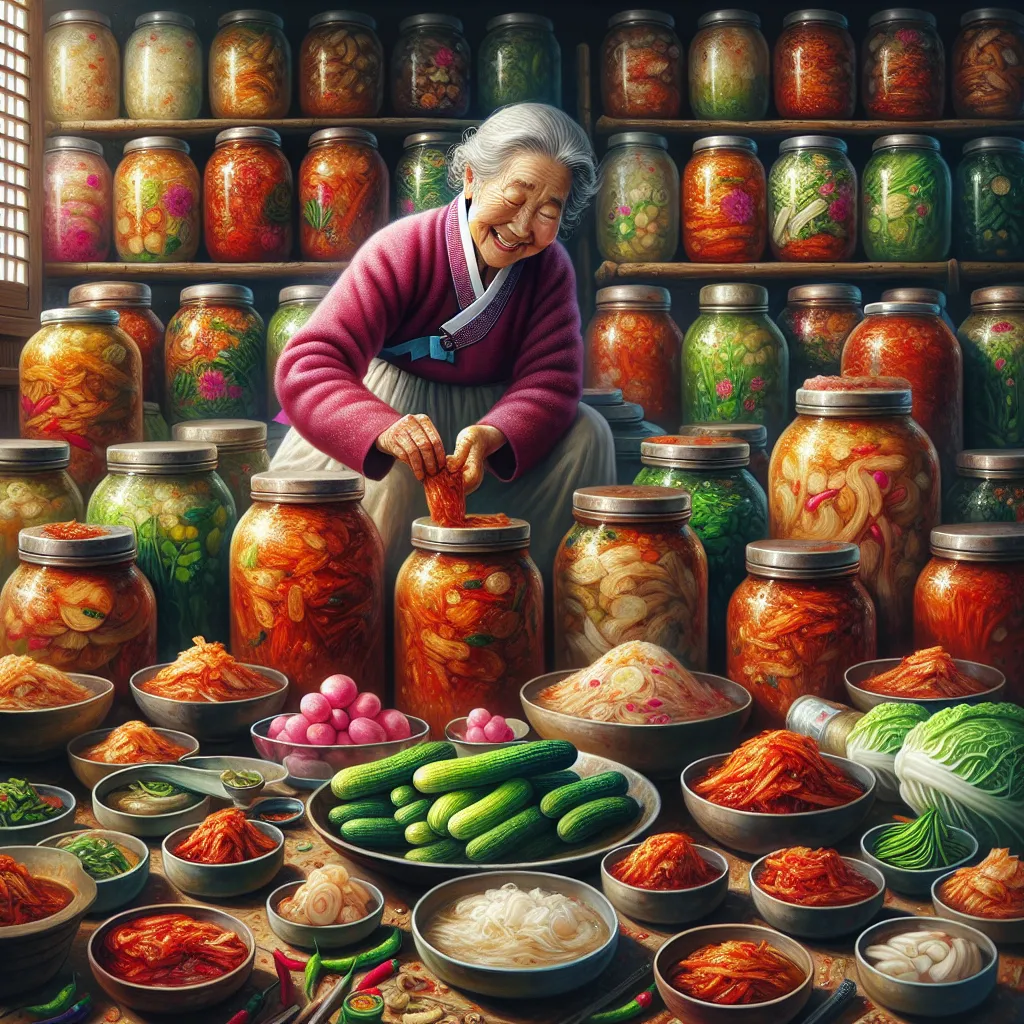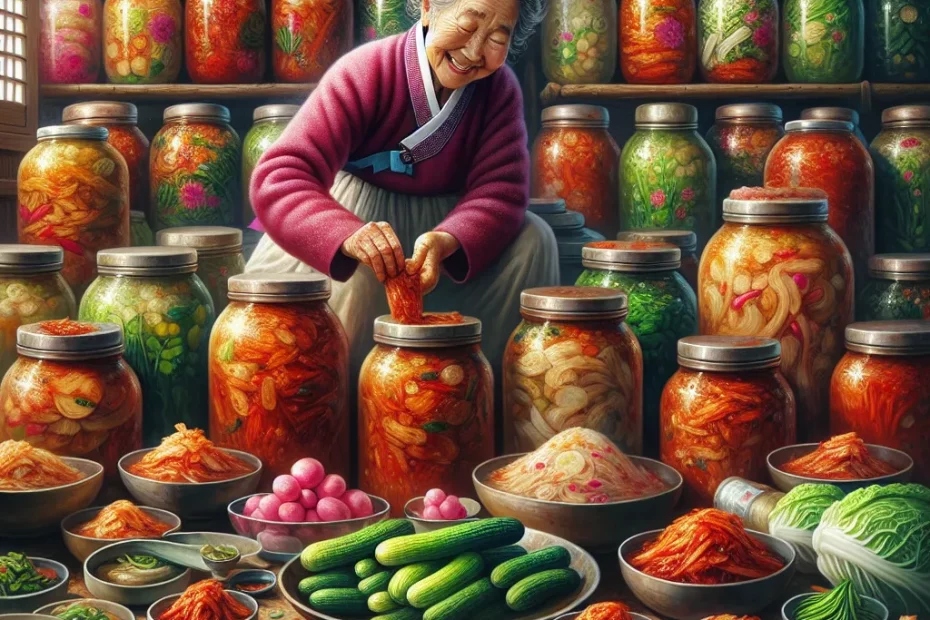Kimchi, the iconic fermented side dish of Korea, has a rich history and diverse variations that make it a beloved staple in Korean cuisine. From its origins rooted in preserving vegetables for the winter to the modern-day health benefits it offers, kimchi is more than just a food – it’s a cultural symbol. Whether you’re a kimchi connoisseur or new to this flavorful dish, there’s always something new to discover and appreciate about kimchi. Let’s delve into the fascinating world of kimchi together and explore the secrets behind its unique flavors and textures.

Origins and History of Kimchi
Hey there, foodies! Today, let’s dive into the fascinating world of kimchi – Korea’s iconic fermented side dish that has captured the hearts (and taste buds) of people all around the globe. 🥢🌶️
The Ancient Roots of Kimchi
Believe it or not, kimchi has a history that dates back thousands of years. This spicy, tangy dish has been a staple in Korean cuisine since ancient times, with records of its consumption tracing as far back as the Three Kingdoms period (57 BC – 668 AD). Can you imagine? That’s a whole lot of kimchi loving right there! 🇰🇷❤️
The Art of Fermentation
The origins of kimchi can be linked to the traditional practice of fermenting vegetables to preserve them for the harsh Korean winters. Back in the day, when refrigeration was but a distant dream, fermenting veggies with a mix of salt, garlic, ginger, and red pepper powder was the way to go. This fermentation process not only preserved the vegetables but also enhanced their flavors, giving birth to the deliciousness we now know as kimchi. 🥬🔥
Diverse and Delicious
As time passed, kimchi evolved and diversified, with different regions in Korea developing their own unique variations of this beloved dish. In fact, there are said to be over 200 different types of kimchi, each with its own special ingredients and preparation methods. From the classic napa cabbage kimchi (baechu kimchi) to the radish kimchi (kkakdugi) and the water kimchi (mul kimchi), the world of kimchi is vast and full of surprises. 🌎🤩
A Global Culinary Superstar
Kimchi’s popularity has transcended borders, making its way onto the plates of people worldwide. Its health benefits, including being rich in vitamins, probiotics, and antioxidants, have contributed to its status as a superfood. Not to mention, the spicy kick and umami goodness of kimchi make it a versatile ingredient that can be used in various dishes, from stews to fried rice and even burgers! 🍔🌶️
So, the next time you take a crunchy, flavorful bite of kimchi, remember the rich history and cultural significance behind this beloved dish. It’s not just food; it’s a symbol of Korean tradition, innovation, and the power of fermentation. Cheers to kimchi – a true global culinary superstar! 🎉🥬
Varieties of Kimchi Across Korea
Welcome to the world of kimchi, Korea’s iconic fermented side dish that has captured the hearts and taste buds of people around the globe! Kimchi is not just a food in Korea; it’s a cultural symbol that represents the country’s rich culinary heritage. As you explore the diverse regions of Korea, you’ll come across a wide array of kimchi varieties, each with its own unique flavors, ingredients, and preparation methods. Let’s take a journey through the different types of kimchi you can find across Korea, from the spicy and robust to the mild and refreshing!
Baechu Kimchi (배추 김치)
Baechu kimchi is perhaps the most well-known type of kimchi, made with Napa cabbage as the main ingredient. This kimchi is seasoned with a mixture of garlic, ginger, Korean red pepper flakes, and fish sauce, giving it a spicy and tangy flavor profile. Baechu kimchi is traditionally fermented in earthenware pots buried underground, allowing it to develop its signature depth of flavor over time.
Kkakdugi (깍두기)
Kkakdugi is a type of kimchi made with cubed radish, seasoned with red pepper powder, garlic, ginger, and other spices. Unlike traditional cabbage kimchi, kkakdugi has a crunchy texture and a slightly sweeter taste. It’s a popular side dish that adds a refreshing contrast to rich and savory Korean meals.
Oi Sobagi (오이 소박이)
Oi sobagi is a unique kimchi made with cucumbers, which are stuffed with a mixture of garlic, green onions, and red pepper flakes. The cucumbers are then fermented whole, resulting in a crisp and refreshing kimchi that is perfect for hot summer days. Oi sobagi is known for its light and clean flavors, making it a favorite among those who prefer milder kimchi varieties.
Dongchimi (동치미)
Dongchimi is a non-spicy kimchi made with radish and other vegetables, such as Korean pear and green onion, in a brine seasoned with salt, ginger, and garlic. This kimchi is enjoyed for its clear and refreshing taste, often served as a cold soup during the summer months. Dongchimi is known for its crunchy texture and delicate balance of flavors, making it a popular choice for those looking for a lighter kimchi option.
Yeolmu Kimchi (열무 김치)
Yeolmu kimchi is a type of kimchi made with young radish greens, which are seasoned with red pepper powder, garlic, and fish sauce. This kimchi has a fresh and slightly bitter taste, with a crunchy texture that adds a unique twist to traditional kimchi dishes. Yeolmu kimchi is often enjoyed in the spring when radish greens are in season, offering a burst of seasonal flavors to the table.
From the fiery heat of baechu kimchi to the cool crispness of dongchimi, the world of kimchi is as diverse and vibrant as the Korean culture itself. Each variety of kimchi reflects the unique flavors and traditions of its region, creating a tapestry of tastes that continues to captivate food lovers worldwide. So, the next time you sit down to a Korean meal, remember to savor the different varieties of kimchi that grace your table, each telling a story of Korea’s rich culinary heritage!
Health Benefits of Kimchi
Hey there, foodies and health enthusiasts! Today, let’s dive into the wonderful world of kimchi and explore the amazing health benefits this iconic Korean dish has to offer. 🥬🌶️
The Power of Probiotics
First off, let’s talk about probiotics. Kimchi is a powerhouse of probiotics, which are beneficial bacteria that promote a healthy gut. A single serving of kimchi can contain millions of these friendly bacteria, helping to improve digestion and boost the immune system. 💪🏼🌟
Vitamins and Minerals Galore
But that’s not all! Kimchi is also packed with vitamins and minerals. It’s a great source of vitamin A, vitamin C, and vitamin K, as well as calcium, iron, and selenium. These nutrients are essential for overall health, supporting everything from strong bones to glowing skin. ✨🍅
The Magic of Fermentation
One of the most unique health benefits of kimchi comes from its fermentation process. During fermentation, the cabbage and other vegetables in kimchi undergo a transformation that increases the bioavailability of nutrients. This means that our bodies can absorb and utilize the vitamins and minerals in kimchi more effectively. 🌿🔬
Weight Management Wonder
Moreover, kimchi is low in calories but high in fiber, making it a fantastic choice for weight management. The fiber in kimchi helps you feel full longer, reducing cravings and overeating. Plus, the spicy kick of kimchi can rev up your metabolism, helping you burn more calories throughout the day. 🌶️💃
Antioxidant Boost
And let’s not forget about the antioxidants in kimchi! Antioxidants are compounds that help protect our cells from damage caused by free radicals, which are linked to aging and various diseases. By including kimchi in your diet, you’re giving your body a powerful dose of antioxidants to keep you healthy and vibrant. 🍀🌈
So, whether you enjoy kimchi as a side dish, in a stew, or even in a sandwich, you’re not just treating your taste buds to a burst of flavor – you’re also nourishing your body with a plethora of health benefits. Cheers to kimchi, the superfood that keeps on giving! 🎉🥗
Remember, a little kimchi a day keeps the doctor away! Stay healthy, stay happy, and keep enjoying the goodness of this fermented delight. 🥰🌟
Tips for Making Homemade Kimchi
Are you ready to embark on a flavorful journey into the world of kimchi making? Get your apron on, gather your ingredients, and let’s dive into the art of crafting this iconic Korean side dish right in your own kitchen! 🥢🥬
Key Ingredients for Homemade Kimchi
First things first, let’s talk about the key ingredients you’ll need for your homemade kimchi. Cabbage, radish, scallions, garlic, ginger, Korean red pepper flakes (gochugaru), and fish sauce are the essentials that will give your kimchi that perfect balance of spicy, tangy, and umami flavors. 🌶️🥒
Preparing the Vegetables
When it comes to preparing the vegetables, don’t be afraid to get your hands dirty! Massaging the cabbage with salt not only helps to soften it but also draws out excess water, ensuring that your kimchi stays crunchy and full of flavor. And remember, the level of spice is totally up to you, so feel free to adjust the amount of red pepper flakes to suit your taste buds. 🌶️🥬
The Fermentation Process
Fermentation is where the magic happens in the kimchi-making process. As your kimchi sits at room temperature, the natural sugars in the vegetables will start to ferment, creating that signature tangy taste. Be sure to pack your kimchi tightly in a clean, airtight container to prevent any unwanted bacteria from sneaking in. And don’t forget to burp your container daily to release any built-up gases! 🌬️🥢
Patience is Key
Patience is key when it comes to homemade kimchi. Letting it ferment for a few days to a week will allow the flavors to develop and intensify. Once it reaches the perfect level of tanginess for your liking, pop it in the fridge to slow down the fermentation process. Your homemade kimchi will continue to mature in flavor over time, so don’t be afraid to enjoy it at different stages of fermentation. 🕰️🥡
So there you have it, some tips to help you master the art of making homemade kimchi! Get creative, experiment with different ingredients, and most importantly, have fun infusing your own unique touch into this beloved Korean dish. Happy fermenting! 🥢🌟
In conclusion, Kimchi is not just a side dish, but a symbol of Korean culture and tradition. Its rich history, diverse varieties, and numerous health benefits make it a beloved staple in Korean cuisine. Whether you enjoy it spicy, mild, or with different ingredients, kimchi is a versatile dish that can be enjoyed in various ways. So, why not try making your own homemade kimchi and experience the joy of fermenting this iconic dish yourself? Embrace the flavors, embrace the traditions, and savor every bite of this delicious and nutritious food that has been cherished for generations. Let kimchi bring a taste of Korea into your home, and let its tangy, spicy, and umami flavors transport you to the vibrant streets of Seoul. Kimchi – a dish that truly captures the essence of Korea!
